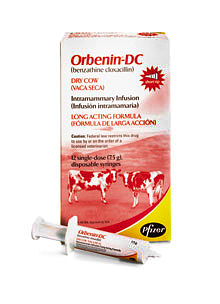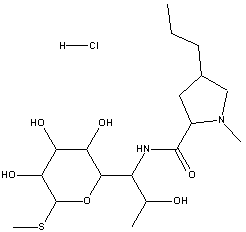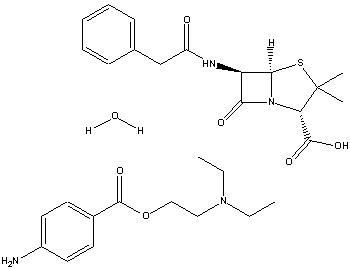Mastitis
Treatment
Antibiotics are delivered
into the teat via a syringe, this prevents more bacteria entering the teat as
well as treating the infection.
Orbenin Dry CowŇ made by Pfizer is a long acting antibiotic against mastitis in dry cows, treats mastitis caused by Staphylococcus Aureus and Streptococcus Agalactiae.
 Orbenin DC- From www.pfizer.co.uk
Orbenin DC- From www.pfizer.co.uk
· Uses: Dry Cow Intramammary Infusion
· Contains: benzathine cloxacillin
·
Description: Stable, non-irritating suspension of benzathine
cloxacillin containing the equivalent of 500 mg of cloxacillin per disposable
syringe. It is a semisynthetic penicillin,
that is derived from the penicillin nucleus, 6-amino-penicillanic acid and is
the benzathine salt of 6-[3-(2-chlorophenyl)-5-methylisoxazolyl-4-carboxamido]
penicillanic acid.
· Action: Benzathine cloxacillin is bactericidal, meaning it kills the bacteria during multiplication. It acts through the inhibition of biosynthesis of cell wall mucopeptide. It is active against Staphylococcus aureus and Streptococcus agalactiae.
· Precaution: Because it is a derivative of 6-amino-penicillanic acid, it has the potential for producing allergic reactions. If this occurs the subject should be treated with tantihistamines,
Lincomycin Hydrochloride plus Neomycin Sulphate – Used for the treatment of mastitis in lactating cows.
 lincomycin
hydrochloride
lincomycin
hydrochloride
Penicillin G Procaine and novobiocin sodium – Used to treat bovine mastitis in dry cows. Penicillin G Procaine is an antibiotic that consists of penicillin and procaine. It is used to treat infections caused by organisms sensitive to penicillin. It is injected into the muscle so that it is released slowly.
 Penicillin G Procaine
Penicillin G Procaine
Keeping Mastitis Low Without Using Antibiotics.
The main trigger of mastitis is the incomplete removal of milk from the udder during milking. The somatic cell count can be kept low by using high doses of antibiotics and getting rid of the milk produced by infected cows, this can be very expensive. The incidence rate of mastitis may increases due to dependence and immunity to antibiotics. The best way to reduce mastitis cases is to prevent infection. Early mastitis detection, sanitised teat wiping, and teat spraying can minimise spread of infection. Mastitis can be detected by udder hardness during teat wiping, blood clots in the teat and checking the filters in the milking machine. An article in Farmer’s Weekly suggested that using clean bedding and reducing the amount of muck around, did not reduce the cases of mastitis, this shows that the bacteria that causes the disease are already present inside the teat, infection has to be triggered by stress for example. It was found that if an udder cream was used at the first signs of mastitis, the infection was cleared. The cream contains essential oils, plant extracts, that have some anti-inflammatory and antiseptic properties, it increases the blood flow in the udder and milk let down, meaning the flow of milk from the teat.